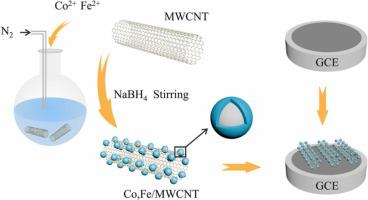Synthetic Metals ( IF 4.4 ) Pub Date : 2022-04-27 , DOI: 10.1016/j.synthmet.2022.117087 Jinghao Wu , Shuangshuang Cai , Qiuyu Kong , Meng Chen , Zuanguang Chen

|
Existing electrochemical sensors generally possess limited sensitivity, which necessitates the use of high-cost materials such as precious metals and enzymes. Therefore, the development of electrochemical sensors that have low synthesis cost, short detection time, simple operating process, high sensitivity and non-precious metals is highly desirable for establishing modern and more efficient electrochemical analysis methods. Herein, we used sodium borohydride reduction method to load Fe and Co onto multi-walled carbon nanotubes (Co,Fe/MWCNT). The successful doping of two metals exposes a large number of active sites in the material and increases the effective area. The morphology and elemental composition of the composite material were determined, and the material was used to modify a glassy carbon electrode for the construction of a hypersensitive electrochemical sensor. Subsequently, the electrochemical behavior of rutin on the constructed sensor was investigated under optimum conditions. The reduction peak current and concentration of rutin were found to exhibit a good linear relationship within the concentration ranges 8 × 10−4–8 × 10−3 µmol/L (R2 = 0.998), 1 × 10−2–0.1 µmol/L (R2 = 0.996), and 1–200 µmol/L (R2 = 0.998). The electrode also showed good reproducibility and a low limit of detection of 2.8 × 10−4 µmol/L (3S0/S). Importantly, the sensor was successfully applied for the measurement of rutin content in tablet and urine. Thus, an effective analytical platform for rutin determination during the analysis of real drug and biological samples was developed.
中文翻译:

碳纳米管材料负载Co、Fe双金属材料的制备及其在芦丁中的应用
现有的电化学传感器通常灵敏度有限,需要使用贵金属和酶等高成本材料。因此,开发合成成本低、检测时间短、操作过程简单、灵敏度高、不含贵金属的电化学传感器对于建立现代、更高效的电化学分析方法非常有必要。在此,我们使用硼氢化钠还原法将 Fe 和 Co 负载到多壁碳纳米管 (Co,Fe/MWCNT) 上。两种金属的成功掺杂暴露了材料中的大量活性位点,增加了有效面积。确定了复合材料的形貌和元素组成,该材料用于修饰玻璃碳电极,用于构建超灵敏电化学传感器。随后,在最佳条件下研究了芦丁在构建的传感器上的电化学行为。发现芦丁的还原峰电流和浓度在 8 × 10的浓度范围内表现出良好的线性关系-4 –8 × 10 -3 µmol/L (R 2 = 0.998)、1 × 10 -2 –0.1 µmol/L (R 2 = 0.996) 和 1–200 µmol/L (R 2 = 0.998)。该电极还表现出良好的重现性和2.8 × 10 -4 µmol/L (3S 0 /S) 的低检出限。重要的是,该传感器成功地应用于片剂和尿液中芦丁含量的测量。因此,开发了一种在真实药物和生物样品分析过程中用于测定芦丁的有效分析平台。


























 京公网安备 11010802027423号
京公网安备 11010802027423号